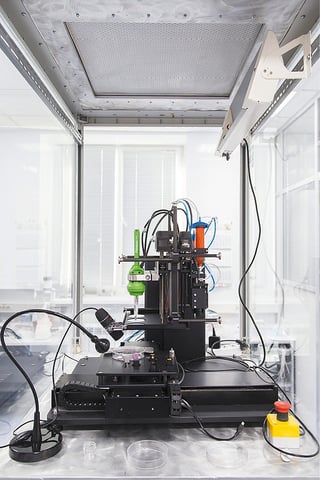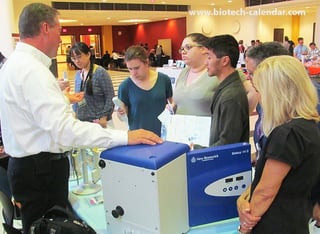On average, 20 people die each day while waiting for an organ transplant, according to the United Network of Organ Sharing. However, scientists at the University of Minnesota envision a day when organ transplants from donors will no longer be necessary. Instead, failing organs will be replaced with ones created by specialized 3D printers. In a giant step toward that goal, researchers have manufactured lifelike artificial organ models using a custom-built 3D printer. These models mimic the exact anatomical structure, mechanical properties, as well as the look and feel of real organs. This research project is supported by two, five-year NIH grants that total over $2.6 million.

(Image of 3D Bioprinter courtesy of Wikimedia)
One of the immediate applications for this technology is improved models for pre-operative practice. In a study recently published in the journal Advanced Materials Technologies, researchers took MRI scans and tissue samples from three patients’ prostates. They tested the tissue and developed customized silicone-based inks that can be “tuned” to precisely match the mechanical properties of each patient’s prostate tissue. The inks were then used in a custom-built 3D printer. The researchers then attached soft, 3D printed sensors to the organ models and observed the reaction of the model prostates during compression tests and the application of various surgical tools.
“We think these organ models could be ‘game-changers’ for helping surgeons better plan and practice for surgery. We hope this will save lives by reducing medical errors during surgery,” the lead researcher Michael McAlpine Ph.D. stated in an article for University of Minnesota News.
Currently, most 3D printed organ models are made from hard plastics or rubbers. Therefore, they differ significantly in the way they look and feel when compared to the real thing. They are often too hard to cut or suture. This limits their application for predicating and replicating the organ’s physical behavior during surgery. Another issue with current 3D printed models in the lack of ability to give quantitative feedback.
The addition of the soft, 3D printed sensors to the organ models “...could give surgeons real-time feedback on how much force they can use during surgery without damaging the tissue,” said Kaiyan Qiu, lead author of the paper. “This could change how surgeons think about personalized medicine and pre-operative practice.”
What’s Next:
Researchers hope to use this new method to 3D print lifelike models of more complicated organs, using multiple inks. For instance, if the organ has a tumor or deformity, the surgeons would be able to see that in a patient-specific model and test various strategies for removing tumors or correcting complications.
However, these individualized pre-operative practice models may be just the beginning. In the future, 3D printed organs may actually be able to be used to replace damaged or failing organs. “If we could replicate the function of these tissues and organs, we might someday even be able to create ‘bionic organs’ for transplants,” McAlpine said. “I call this the ‘Human X’ project. It sounds a bit like science fiction, but if these synthetic organs look, feel, and act like real tissue or organs, we don’t see why we couldn’t 3D print them on demand to replace real organs.”
Lab Suppliers Meet with U of M Researchers at Bioresearch Product Faire:
|
RELATED ARTICLES: Research News: U of Minnesota Grows Blood Vessels in LabUMinn: Top Funded Research Projects Right NowTexas A&M: 3D Printed Bone the Future of Facial Surgery |
In 2017 The University of Minnesota received over $245 million in research funding from the National Institute of Health to support ground breaking studies like this one. U of M spends more than $870 million on research annually.
Those wishing to sell lab equipment and supplies to these well funded researchers, should plan on attending the 18th Annual BioResearch Product Faire™ event at the University of Minnesota. This event will be held on Thursday, May 3th, 2018. It is an excellent opportunity to meet face to face with the U of M scientist and discuss their needs and educate them about your products.
For more information on how to increase your lab product sales in 2018 by displaying at this event call (530) 272-6675 or click on the link below:

Life science professionals are invited to attend this on campus bioresearch product faire for free. Click the button below for additional information or to pre-register.




